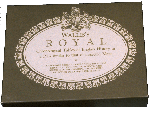
No one really knows when the idea for a jigsaw puzzle came about. Perhaps in the same manner in which we use jigsaw puzzles today - a few thousand years ago ancient Egyptians and other Middle Eastern peoples played with broken clay tablets - but there is no real evidence that this is so. What we do know is that a number of factors came together in Europe by the 18th century which gave rise to the jigsaw puzzle industry in North America and elsewhere as it is today.
From the 16th century onward the French, Dutch, Germans, and British were publishing books and modifying adult gambling and board games especially for use in the education of middle-class and royal children. As to which country was first - the evidence is somewhat clouded. For example, while the French word casse-tete chinois (a type of non-jigsaw puzzle from the Orient) appears in the French language as early as 1706, Hannas1 writes that in 1750, John Jefferys (an early British maker of jigsaw puzzles) may have known that
...for the past hundred years the French had been utilizing their gambling games for educational purposes. He may even have seen one of the several spiral games, using small maps... published in Paris from 1650 onwards by Pierre du Val, geographer to the King. These, stated du Val, were for teaching geography to youth and the ladies in an entertaining manner.
An original Dissected Map of Europe (a jigsaw puzzle designed by Le Sr. Janvier, a geographer in Paris), which was published in 1786, now resides in Colonial Williamsburg.
On the other hand, there are Dutch jigsaw puzzles which exist today that the Bekkerings indicate might have been manufactured by a Dutch firm before 1760. According to the Bekkerings:2
In the Netherlands, we have seen several pre-1760 maps by Covens and Mortier of Amsterdam, which were made into jigsaw puzzles. These maps were printed around 1720-30, but were outdated by 1760 since ongoing discoveries continued to add large sections of shorelines to newer maps printed after 1730. We have not be able to find proof that these early Dutch maps were made into jigsaw puzzles before 1760. We have found that Covens and Mortier advertized their puzzles in 1779, so it is possible that C&M used old maps in the manufacture of their jigsaw puzzles.
It is well known that German book collections from the 18th century include a range of children's books. Europeans from a number of countries at the time were attending the annual Leipzig Book Fair to see what was new in books for children. People still do this today. However, there is no evidence that the Germans were manufacturing jigsaw puzzles as well as children's books in the 18th century.
Hannas3 indicates that the first British books for children were published about 1744 and a geographer developed the first British "educational" game for children from a popular adult pub game in the 1750s. This children's board game was printed by a mapmaker in London. The reality of a market for children's books and games then began to take hold in England during the next decade.
In the 1760s John Spilsbury (owner of a print shop in Russell Court, London) who made maps and charts, stationery, bibles, almanacs, and the like "to suit every taste and pocketbook", began to sell a "dissected" or cut-up map for use in teaching geography to children. Spilsbury's engraved hand-colored map was glued to a thin mahogany board, and cut with a saw along the boundaries of countries and counties. It sold well, and Sabins4 tells us other entrepreneurs entered the market quickly cutting up and selling maps and other types of engravings.
Engravings of popular subjects such as farming or illustrations from popular books of the period became "fun puzzles" for both children and adults. Special "adult" jigsaw puzzles made use of poems and stories from British daily tabloids. Some puzzles were exported to British colonies in North America and elsewhere (to India for example, see Rudyard Kipling's story Lizpeth), and by the late 19th century industrial development and the growth of trade had brought jigsaw puzzles to many more countries around the world.

In addition to maps intended for educational purposes, a number of other engraving subjects were made available as jigsaw puzzles. A typical one was John Wallis' Chronological Tables of English History for the Instruction of Youth (1788). Click on the image to the right for more details and photos from the collection about this and related puzzles of the 18th century.
Notes:
Last update April 2, 2010